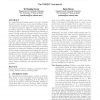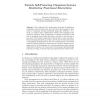321 search results - page 20 / 65 » Towards a Computational Model of Perception and Action in Hu... |
KCAP
2009
ACM
14 years 2 months ago
2009
ACM
As computational learning agents move into domains that incur real costs (e.g., autonomous driving or financial investment), it will be necessary to learn good policies without n...
PUC
2006
13 years 7 months ago
2006
The requirement for spontaneous interaction in ubiquitous computing creates security issues over and above those present in other areas of computing, deeming traditional approaches...
MIDDLEWARE
2005
Springer
14 years 1 months ago
2005
Springer
The vision of pervasive or ubiquitous computing, conceived by Mark Weiser, foresees a world where computing is embedded in every day objects. Such objects interact with each other...
CHI
2004
ACM
14 years 8 months ago
2004
ACM
Facial affect (or emotion) recognition is a central issue for many VMC and naturalistic computing applications. Most computational models assume "categorical perception"...
CVPR
2010
IEEE
14 years 3 months ago
2010
IEEE
We propose a data-driven, hierarchical approach for the analysis of human actions in visual scenes. In particular, we focus on the task of in-house assisted living. In such scenar...


